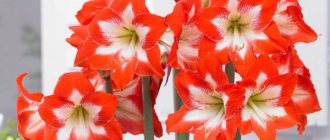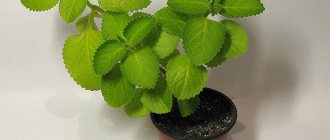Author: Elena N. https://floristics.info/ru/index.php?option=com_contact&view=contact&id=19 Category: Garden plants Published: February 28, 2019Last edits: January 20, 2021
- When to plant
- How to take care of the garden
- Natural views
Daylily is called the lily for the lazy. And the Czech writer Karel Capek, who was in love with gardening, dubbed daylilies “the flowers of the intelligent lazy person.” Probably the poet of gardening dealt with natural species of daylily; they are indeed very unpretentious. But if you want to see something more intricate in your garden than the usual red and yellow daylilies, you will have to get to know the character of this plant better!
- Why does the daylily suddenly stop blooming magnificently?
- How to prepare for the awakening of dormant daylilies in the spring?
- What varieties of daylilies are the most fragrant?
- What daylilies can be grown in a pot?
- Is it true that white daylilies are just an advertising ploy by breeders?
Read our article.
Planting and caring for daylilies
- Planting: sowing seeds in open ground before winter or in spring after stratification of the seed. Divide and replant in the spring, at the end of April or beginning of May.
- Flowering: depending on the type and variety from May to August.
- Lighting: bright sun, partial shade or shade.
- Soil: any garden soil, except sandy. The optimal soil is rich, well-drained loam with a neutral or slightly acidic reaction.
- Watering: infrequent, but plentiful. Water is poured at the root.
- Feeding: complete mineral fertilizer in the spring, when leaves grow, and a month after the peak of flowering.
- Reproduction: varietal plants - by division followed by replanting in August or separating the daughter rosette without digging up the plant. Species plants can be propagated by seed.
- Pests: thrips, water voles, lily gnats, slugs.
- Diseases: root rot, fusarium, rust.
Read more about growing daylilies below.
Daylily (lat. Hemerocallis) , or red daylily , is a herbaceous rhizomatous perennial of the subfamily Daylilies of the Asphodelaceae family. Homeland - East Asia. Daylily has been known to mankind since ancient times, but science first started talking about it in 1753, when Carl Linnaeus gave it the name “hemerocallis,” which consists of two Greek words: “hemera,” which means “day, day,” and “callos.” , which means “beauty.” In Russian the plant is called krasodnev, that is, beauty that lives only one day.
Not only cultivated species and varieties of daylilies are beautiful, but also “savages” growing in nature. In addition, daylily flowers are so unpretentious that gardeners call them the lazy gardener's plant, but this is only true for old varieties. In recent years, thanks to American and Australian breeders, daylilies have found themselves at the peak of fashion: new varieties, although more capricious than the previous ones, are so incredibly beautiful that you don’t regret the time or effort spent on them.
- Winter juniper cuttings are an even more effective way
About species and varietal daylilies
Species daylilies are very popular among Russian flower growers. Varietals go through selection. It takes a lot of time. They are unpretentious and resistant to cold. Unless the arid south does not suit them.
Winter-hardy varieties are used in design.
Daylilies were first described by Pliny in his treatise Natural History. Then, in the 70s AD, Dioscorides said that the flowers and leaves of yellow daylily have medicinal properties.
And in the 15th century, “Herbalists” began to be produced in Europe, where famous varieties were also described.
Daylily yellow
Belongs to Asian varieties. In Russia, he loves the slopes and outskirts of forests, the banks. Blooms in early summer. Up to a meter high.
The flowers are fragrant, lemon-colored, the inflorescence contains about ten pieces. The foliage is wide, bright, attractive.
Daylily brown-yellow
The origin of this daylily could not be established, but the geography of its growth is extensive. Its dried flowers are called golden needles.
Each new flower grows in the fold of the old one in the opposite direction. It is soft underneath, although hard on top. Peduncles are bare and longer than the foliage.
The number of yellow-orange flowers, similar to lilies, can reach 20. Their inner part is red, the perianth lobes have wavy edges.
Of interest are the semi-double and terry forms. Ordinary flowers become double over time.
Daylilies are suitable for any conditions. When snow falls, he is not afraid of even forty-degree frost.
Small daylily
In Russia, Siberia is close to this daylily. Graceful daylily bushes are low, not much more than half a meter in height.
Narrow leaves touch the ground. There are up to five flowers in an inflorescence; they appear at the end of spring, and in June they already bloom profusely.
Daylily Middendorf
Daylilies do not grow only in Kamchatka. Slopes, deciduous forests, and cliffs suit them. The foliage is drooping and narrow.
Near the base of the fresh leaf blades you can see the remaining leaves from last year. Fragrant orange flowers in tall peduncles.
Daylilies bloom in May and throughout the fall. Seed ripening occurs in July.
Modern varieties are tetraploids. After the first flowering cycle, they undergo a second. The main thing is that the summer is warm and long. It is a mistaken belief that only tetraploids are charming.
Diploid varieties are just as beautiful, with large flowers with serrated petals. You can see watermarks, colored borders, and flounces on them.
If the summer is cool and there is little sun, the perianth will not be able to open. However, the bright sun can also destroy flowers.
This is possible with some varieties, so for them you need to choose partial shade.
Remember that it is better to buy seeds from people you know. If you come to the exhibition for seed material, also choose proven ones. It is even more risky to buy from someone else.
Even if you are interested in modern varieties, do not give up old, well-proven ones. Among them there are interesting samples. One of them has yellow flowers and a lilac underside, the other has orange...
The store may sell re-sorted items. Although if you do buy seeds there, do the following. When you get home, plant the division in a shallow container so that all the roots fit. The soil should be slightly damp.
Then cover the container with a plastic bag with several holes and place it in the refrigerator. Ventilate it every week, moisten it and check for mold formation.
If necessary, buy Fitosporin M for spraying. When April arrives, place the container on the windowsill and water as needed. And in May, harden off and plant.
In another article we described a flower called Heliopsis.
Botanical description
Daylily adventitious roots are cord-like, usually fleshy, thick, and this helps the plants survive in drought. The leaves are basal, broadly linear, two-rowed, arcuate or straight. Daylily flowers are six-parted, large, most often funnel-shaped, orange, yellow, red-brown or yellow, collected several times in inflorescences. Up to three flowers bloom at the same time, and the total flowering period of a daylily bush is more than three weeks. One or several peduncles are leafy, depending on the type and variety, from 30 cm to 1 m in height, sometimes even higher. The fruit of the daylily is a triangular capsule with seeds. In gardening, both natural plant species and numerous cultivated varieties and forms are used.
Use in landscape design
Its unpretentiousness, duration of flowering and decorative effect throughout the growing season open up great possibilities for the use of daylily in landscape design. The plant is suitable for single planting and goes well with other plants.
Daylily looks good in group plantings next to astilbe, phlox, and irises. Framing the composition with plants with decorative foliage - hostas, heucheras - looks beautiful. Leaf rosettes of daylily go well with late-blooming perennials - asters, chrysanthemums. A flowerbed with blooming daylilies looks interesting when planted in the background and between bushes of ornamental grasses.
Flower in plant composition
Many gardeners love daylilies for their ease of planting and care, beautiful and long-lasting flowering. Beginning gardeners can be advised to begin their acquaintance with flowers by growing natural species and well-known varieties that have proven themselves to be hardy and winter hardy.
Growing daylilies in the garden
Growing conditions
In nature, in their natural habitat, daylilies grow among shrubs on the edges of forests, so logically it is best to grow it in partial shade, and this will be correct if the partial shade is in Australia, Africa or the south of France. In our gardens, daylilies planted in partial shade may not have enough light and heat for full flowering, especially when it comes to hybrid varieties. Only bright sunlight will make the daylily bloom unique.
In the photo: Growing daylilies in a flower bed
The soil
As for the soil for the daylily, although the plant is unpretentious and any garden soil will suit it, but if you want to get the maximum benefit from the daylily, it is better to adjust the soil in which you immerse the daylily root in accordance with its tastes: add sand to clay soil and compost, enrich sandy – clay, soddy-podzolic soil with compost.
The ideal soil composition is rich loam with good drainage. In terms of acidity, the soil should be neutral or slightly acidic.
If creating good drainage for the area is a problem, make raised beds for daylilies. Otherwise, daylilies require attention, but do not cause trouble.
What colors do daylilies go with?
Daylilies in garden design are used both as single plants and as group plants. They look great against the background of trees and shrubs (viburnum, paniculata hydrangea, bamboo). Densely bushy varieties of daylily make very beautiful borders, and low-growing, small-flowered species and varieties are very good near stone hills, on the banks of a pond or river. Daylilies are also used as decoration for winter gardens; cut flowers last a long time in bouquets.
In the photo: Orange daylilies in the garden
Since by the end of summer many daylilies lose their decorative value, think in advance about what plants to plant them in composition with so that the yellowed, dying daylily leaves are not visible.
Designers advise using ornamental grasses, physostegia, yarrows of different shades or point loosestrife.
Propagation using seeds
Daylilies grown from seeds, as a rule, lose the characteristics of the variety; plant breeders propagate the plants with seeds, and for the garden it is better to purchase seedlings. Having decided to experiment with growing flowers from seeds, you need to know all the features of this process.
The seeds of the plant are soaked in water diluted with hydrogen peroxide, 15 ml of a three percent peroxide solution per 1 liter of water. Cover the seeds in the container with plastic wrap and leave in a dark place.
It takes 4 to 14 days for the seeds to germinate, so look under the plastic every day and check whether the seeds have sprouted or not.
As soon as you see white roots, drain the water, pour fine gravel into another container and distribute it evenly along the bottom. Place the seeds on top, it is necessary that the roots are in the water and the seeds are above its surface. It is recommended to add the drug Epin to the liquid; one drop is enough per glass of water.
Place the seeds in the container in the light, while the water level should be maintained at the same level. You can simply inject liquid from a spray bottle when necessary.
Thanks to illumination, daylilies can be grown starting in October; when this is not possible, the seeds should be soaked in March.
This method also has its disadvantages: sometimes a completely different variety appears in the flower bed than is depicted on the bag of seeds. However, any daylily looks beautiful and gives others positive emotions.
Planting daylilies
When to plant
Plants are planted from spring to autumn - planting time depends on your climate. If winter comes early and quickly in your area, it means that a daylily planted in the fall may not have time to take root before frost and will die, because on average a plant needs a month to take root. But if you choose garden forms with an early or medium flowering period, then even in latitudes far from the south, your daylilies can have time to prepare for winter in the garden. In addition, mulching a bed with wintering daylilies can protect them from cold and frost.
In the photo: How daylilies grow in a flowerbed
Based on these considerations, decide when to plant flowers. Flower growers believe that the best time to plant daylilies in the middle zone is May or August. It is also better to divide and replant daylilies in spring or August.
How to plant
Before planting a daylily, pre-purchased planting material must be soaked in water or highly diluted mineral fertilizer several hours before planting in the ground so that the roots swell and come to life, and then you will immediately see which roots should be carefully removed. Trim the remaining roots to 20-30 centimeters in length.
In the photo: Young daylily
Dig a separate hole up to 30 cm deep for each bush or division, and do not forget that you are planting daylilies for a long time, and the bush, which has grown over time to 50-70 cm in diameter, should not be crowded. Pour a mixture of sand, peat and humus into each hole, add ash with superphosphate or potassium-phosphorus fertilizer, lower the roots into the hole, distribute them over the mound so that there are no voids left under the roots, fill the hole with soil, but not completely.
Plant a heuchera - it will look great next to it
- Erigeron (small-petaled): planting and care, types and varieties
Next, holding the plant with one hand, squeeze the soil well around it, water it generously, filling the hole to the brim with water (if the water is quickly absorbed, it means you haven’t compacted the soil well, so add dry soil on top and compact it again), and only now pour soil to the edges of the hole. It is very important that the root collar of the daylily is at a depth of no more than 2-3 cm, otherwise growth retardation and the risk of plant rotting are likely. If you did everything correctly, then the moisture received during planting should be enough for the plant to take root.
Transplanting daylilies
Daylilies grow in one place for up to 15 years, but age affects the quality of flowering. As soon as you notice that your already middle-aged, luxurious daylily has begun to lose its former beauty, there are fewer flowers on its peduncle, and they themselves are smaller, which means it’s time to plant the bush. Dig up the bush along its outer border and carefully remove it along with a lump of earth, being careful not to damage the roots. Place the roots under a strong stream of water to wash away the soil, then carefully separate into individual fans.
With a certain skill, you can do without knives or pruners, but if you still have to cut the roots somewhere, treat the wounded areas with a fungicide.
It is best to plant and replant plants in cloudy weather, and if you had to wait for it, bury the divisions and daylily bushes in the sand so that new roots do not immediately begin to grow, and you can not remember about them for two weeks. Before planting, shorten the roots, removing rotten and dead ones, trim the leaves to 15-20 cm in the shape of an inverted letter “V” and plant the division in the place that you determined for it in the manner described above.
In the photo: Dense planting of daylilies
Classification of daylilies
In America, there is a special society that has been classifying this crop for more than 70 years - ANS (the Latin name of the plant is Hemerocallis) and is its official registrar. As a result of the enormous work he did, the entire decorative potential of this perennial was reflected and it was divided into groups according to the main characteristics of flowering crops. First of all, it is necessary to distinguish between species and varietal differences, which are worth dwelling on in more detail.
A daylily can grow and bloom in one place for more than 10 years.
Caring for daylilies
How to take care of the garden
Daylilies are a lot of fun, but require very little attention. For example, they do not need to be watered frequently. Daylilies need watering only during prolonged drought, but then they need to pour plenty of water under the roots to deeply saturate the soil with water; watering time is evening.
The amount of fertilizing depends on the quality of the soil in the garden, so determine for yourself how many times you will have to fertilize the soil around the daylilies, which are better to underfeed than to overdo it with fertilizers, but two fertilizing is required.
- The first feeding with complex mineral fertilizers is carried out in the spring, when the leaves begin to grow: dry granules are scattered between the bushes, then they are “sealed” with a rake, and the ground is well watered.
- The second mandatory feeding is carried out in August, a month after the peak of daylily flowering, during a short dormant period, in order to ensure the quality and quantity of next year's buds, which are laid during this period. Kemira-plus is considered the best fertilizer.
And remember: after fertilizing, water the plants well.
Mulching the soil is of particular importance. This is done so that the soil above the root collars does not become compacted. The center of the bush is mulched with coarse river sand in a layer of up to 3 cm. The soil between the bushes is mulched with peat or compost if the soil is poor, but if the planting is located on rich soils, then it is better to mulch with pine needles or tree bark. They do this in order to protect plants from temperature fluctuations, preserve moisture in the soil and prevent the appearance of weeds. The mulch layer should be 6-7 cm.
If for some reason you do not want to mulch the area with daylilies, do not forget to loosen the soil after watering, destroy weeds and remove wilted flowers.
Daylily propagation
In August, it is time to replant daylilies, at the same time dividing the bushes. This is a vegetative method of propagating daylilies, which we have already discussed in detail. In addition to dividing the bush, daylilies are propagated by seeds, but this species does not retain varietal characteristics, therefore it is used only by breeders to develop new varieties. There is another way to propagate daylilies - without digging up the main bush, but it is only suitable for varieties that form loose bushes.
Planting and caring for dahlias - detailed information
At the 3-4th year of the daylily’s life, the daughter rosette formed by it, which has already formed roots, is separated: a sharp shovel is placed vertically at the site of the intended cut and a part of the bush is separated with a sharp pressure of the foot, then the section cut off from the mother bush is cut from below, removed from the ground and transferred to transfers to another place. Cuts and damaged roots are treated with ash or crushed coal. This should be done in the spring, when the leaves are just beginning to grow, or in the fall after cutting the leaves from the daylilies.
Pests and diseases
Daylilies rarely get sick or are affected by pests, however, problems sometimes arise. The most dangerous pests for daylilies are thrips, lily gnats, water voles and slugs.
Thrips penetrate plants from the ground at a temperature of 10-12 ºC and begin their destructive life activity for plants: they suck the juice from the leaves, stems and petals, which causes the flowers to become deformed while still in buds. If you find thrips, dig up the plant and destroy it along with them - burn it. As a preventive measure, treat the soil around daylilies with insecticides in spring and autumn and do not leave plant debris that may contain pests in the beds for the winter.
- Maiden grapes: planting, garden care, types and varieties
The lily gnat lays larvae in plant buds, and the larvae, as they grow, feed on the flowers and deform them. But this is not a mass phenomenon, so it is enough to simply remove damaged flowers.
In the photo: Large white daylily
Water voles love to feast on more than just daylily roots. The trouble is that every three or four years there is a peak increase in the number of rodents, and then they eat the roots of young apple trees, the bulbs of lilies and tulips, and the roots of daylilies. It is impossible to get rid of them, but you need to fight them using the usual methods of rodent control.
You will have to collect slugs by hand or use the drug Groza.
As for diseases, daylilies most often suffer from fusarium, rust and root rot.
Root rot appears in the spring, when young leaves that have grown back suddenly stop growing, turn yellow and are easily pulled out of the ground. You need to dig up the plant, cut out all areas affected by rot, wash the rhizome in a pink solution of potassium permanganate, treat the wounds with a fungicide, dry the rhizome for two days and transplant it to another place. Don't expect it to bloom for two years. Do not plant daylilies in the area where the diseased plant grew for at least a year.
In the photo: Daylily after the rain
Rust appears in daylilies only if patrinia grows somewhere nearby - do not place them next door, and you will not have trouble. For prevention, thoroughly treat daylilies with fungicides.
Fusarium is a well-known problem. Affected plants have a depressed appearance, the leaves turn yellow and die prematurely, and the roots look like rot. The disease is fungal, destroyed at an early stage with fungicides. If the infection is in full force, the plant will have to be burned, the soil where it grew, and neighboring plants will need to be sprayed with Fundazol. As preventative measures, sterilize gardening tools, add Fitosporin-M to irrigation water, and loosen the top layer of soil after watering.
In the photo: Growing daylilies in the garden
Features of care
Remember the main thing: complete fertilization of the land, plenty of water and natural light are important. With the arrival of spring warmth, fertilize the soil using potassium and nitrogen.
To do this, dissolve a tablespoon of potassium and the same amount of nitrogen in 10 liters of water. Expect to use half a liter of solution for each flower.
When flower stalks appear, phosphorus feeding will be needed. To do this, loosen a tablespoon of the substance under each bush.
If the daylily has faded, take a tablespoon of potassium and the same amount of phosphorus and dissolve it in 10 liters of water.
In subsequent years, either in the spring, sprinkle ash (half a glass is enough), and in the fall - rotted manure in a small amount or "Gumi" or "Fitosporin".
Additionally, daylilies do not need to be fed. Try “AVA” fertilizer - one teaspoon is enough for the soil every three years.
Remove buds and flower stalks that have already completely faded. This way you will help the daylily maintain its decorative properties.
Daylilies after flowering
According to one classification, daylilies are divided into deciduous, or dormant, semi-evergreen and evergreen. Dormant daylilies are distinguished by the fact that in the fall their leaves wither, die, and the plant goes into a dormant state until spring. Evergreens in our latitudes have only a two to three week rest period. Semievergreens occupy an intermediate position: in warmer climates they behave like evergreens, in cool climates they behave like deciduous ones: the leaves turn yellow, but growth does not stop completely.
How to plant and care for irises - in detail
For deciduous or dormant daylilies, it is better to cut off the above-ground part for the winter, but not too low, leaving 15-20 cm above the surface. There is no need to cover them , since dormant daylilies are winter-hardy plants. However, in the eastern and northern regions of the country, in the event of a snowless winter, evergreen and semi-evergreen daylilies may freeze, especially if frosts are -20 ºC or lower. Therefore, for the winter it is better to cover them, like newly transplanted bushes, with dry leaves, spruce branches, straw or sawdust, but in early spring do not forget to remove the cover, since daylilies wake up very early.
Variety of varieties
There are over 30 thousand varieties of daylily, each of them has its own characteristics; the real decoration of a summer cottage are the terry varieties, characterized by lush flowering.
Decorative daylilies have basal leaves that look very beautiful together, reminiscent of an oriental fan. In some species, longitudinal stripes of white or yellow flowers are visible on the leaves.
Plant hybrids are also worthy of the attention of amateur gardeners; thanks to daylily, your garden will become more beautiful.
Types and varieties of daylily
Natural views
All natural types of daylilies are beautiful, so they are readily used in floriculture, especially since they are very easy to care for and undemanding to growing conditions. In addition, they are resistant to diseases and pests, tolerate drought and waterlogging well, and, finally, they are durable. Popular species are yellow daylily, red daylily, Du Maurier daylily, lemon yellow daylily, and Middendorff daylily. Let's talk a little about some:
- orange daylily – leaves are hard, dark green, up to 3 cm wide, sharply curved, peduncles are branched at the top, up to a meter high, asymmetrical flowers, up to 12 cm in diameter, orange in the middle with a red-brown tint, blooms in July, no smell . In culture since 1890;
- Lemon yellow daylily is found only in areas of Central China, its flower shape resembles a white lily, and it has a nocturnal flowering type. It forms a bush 80-90 cm in height, peduncles are tall, branched at the top, flower length is up to 14 cm, width is 12 cm, the aroma is pleasant and very strong. Blooms for up to forty days in the second half of summer;
- Dumortier's daylily , or wolfberry , grows in Northeast China, Japan, Korea and the Far East. Compact bush up to 70 cm tall, bright green leaves 2-2.5 cm wide, peduncles at the level of the leaves, 2-4 yellow-orange wide open flowers 5 cm in diameter form a dense inflorescence. A favorite of breeders. In culture since 1830.
In the photo: Lemon yellow daylily
In the photo: Orange daylily
Hybrid daylily
Or garden daylily - the general name of numerous varieties of hybrid origin, of which there are currently more than 60,000. The greatest contribution to the selection of daylily was made by American and Australian flower growers, who managed to create species that differ in flower shape, the presence or absence of aroma, flowering time, height and such a wide range of colors that it is difficult to say what color daylily is not in cultivation. Hybrid daylily is the subject of a voluminous and structurally complex classification, in which plants are divided according to the length of the peduncle, the shape and size of the flower, flowering time, color, type of vegetation and many more characteristics, and we will not delve into the presentation of this scientific work, created to a greater extent for scientific specialists. Let us introduce you to some interesting types and varieties of daylilies that will help you get an impression of this amazing and beautiful flower.
Daylilies group double
This is, simply put, a double type of daylily that has additional perianth petals. All varieties are incredibly beautiful. For example:
- Daylily Double Cutie – flower diameter – 10 cm, chartreuse-colored petals, green throat, mid-early flowering;
- daylily Double Dream - apricot-colored petals with a dark orange throat 12 cm in diameter, bush height 60 cm, basal leaves;
- daylily Double Red Royal - the flowers are large, dark red, the petals resemble royal velvet. The shape of the flower is unusual: the outer petals are large, inside them there is an openwork rosette of smaller petals. The plant produces up to 30 peduncles, each with 10-20 flowers. Daylily reblooming.
In the photo: Daylily Double Dream
In the photo: Daylily Double Yellow
In the photo: Daylily Double Cutie
Arachnid daylilies (spiders)
Varieties with flowers whose segments are much longer than wide and resemble spiders in shape:
- daylily Helix - a huge spider with a green throat, gradually turning into yellow petals, the ends of which are dark crimson - very beautiful;
- Arms to Haven is a giant with a yellow-green throat and lilac-red long petals, blooms profusely, height 90 cm, 16-20 flowers on a peduncle;
- Free Healing is a very large spider of creamy yellow color and a red throat, thin petals are very elongated, up to 45 buds on one peduncle.
Fragrant daylilies
They come in all colors, shapes and sizes. Daylilies are so beautiful that they could have no scent at all, but growing a flower in your garden that combines beauty and a wonderful aroma is the dream of any gardener:
- Apple Spring - soft pink petals with a heavily ruffled greenish-yellow border around the edge. The diameter of the flower is 15 cm, on each peduncle 65 cm high there are up to 28 fragrant flowers;
- Ode to Faith - deep yellow color with a pink tint along the middle stripe of the petal, golden ruffled border, green throat. Peduncle height 84 cm, flower diameter – 15 cm, delicate aroma;
- deciduous daylily Stella do Oro - delicate, fragrant, ruffled dark yellow funnel-shaped flowers 7 cm in diameter bloom profusely throughout the summer. This variety is the winner of many awards from the American Daylily Society; it is beautiful not only in the garden, not only as a border plant, but also as a houseplant.
In the photo: Daylily Ode to Faith
In the photo: Daylily Stella do Oro
White daylilies
It must be said that among the varieties and forms of daylilies there are many that can conditionally be called white. Here are some of them:
- Apple Blossom White is a white daylily with a yellow, heavily ruffled border. Height – 83 cm, on peduncles there are 2 branches with 25 flowers;
- Ruffled Parchment - ruffled white daylily with a smooth transition from creamy white to yellow in the throat area, very fragrant, flower diameter - 13 cm, peduncle height - 5 cm;
- Granny Smith - almost white petals with a green ruffled border.
In the photo: White daylily
In the photo: White daylily
The fact is that absolutely white daylilies do not exist either in nature or in culture, so breeders introduced the expression “near white”, which means almost white. In fact, the petals of daylilies, called white, are very light shades of cream, melon, pink, lavender or yellow.
Currently, scientists are working towards increasing the doubleness and diameter of the flower, increasing the corrugation of the petals, and daylily is such a promising material for breeders that we can expect many new beautiful varieties and forms in the very near future.
Flowering period and after care
Daylily throws out flower stalks, each of which contains 10-30 buds. Every flower blooms in the morning and fades in the evening. At the same time, 2-3 flowers bloom on one peduncle. The flowering period lasts 30-45 days. Early varieties begin to bloom in June, late varieties - in August-September. By selecting a collection of varieties, you can achieve flowering of daylilies in your dacha from early summer to late autumn.
Perennial flowering
Interesting information! There are nocturnal varieties of daylilies, the flowers of which bloom in the evening and fade by morning.
Many gardeners are interested in how to properly care for blooming daylilies. In order for the plant to maintain its decorative appearance, faded flowers must be regularly plucked out. This stimulates new buds to bloom. An unkempt plant with wilted petals looks sloppy.











